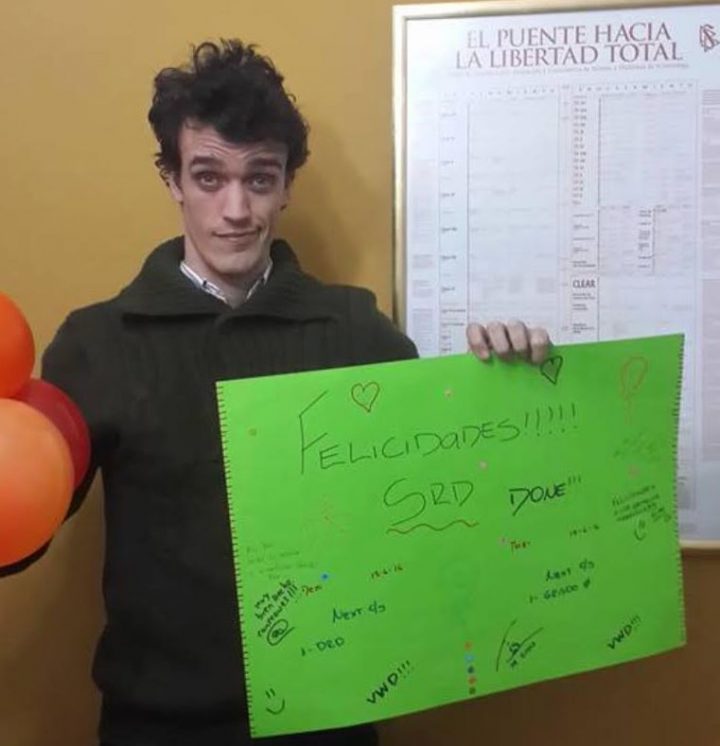This week, documents became available that had been submitted by Narconon Holland, the Scientology drug rehab center in the Netherlands. At a quick glance, they indicated that the place was in serious trouble. And now, Underground Bunker regular “John P.” — who enjoys telling us about his luxurious life in high finance — has broken down those documents in more detail, as only he can. For our newer readers, you will sense that John P. is having fun with his reports about himself, but when he dives into a financial report like this, he’s all business. We hope you enjoy his analysis…
School’s out, and at Global Capitalism HQ, that means one thing: lots of cheap, talented and well-meaning but inept interns to burden with menial tasks. I’m not one of those cruel, sadistic traders who sends an intern out to stand in the hot sun for hours to be first in line at Shake Shack to put in their lunch orders. Instead, I assign Harvard and Yale B-students intellectually tedious research that most people wouldn’t assign to high school kids. At least, people wouldn’t assign this stuff to any high school students they actually liked.
I turned two of the interns loose with Google Translate and a spreadsheet to translate everything as best they could and to do some simplistic analysis on the Dutch Narconon financial statements. I took their best effort, fixed their charmingly naïve mistakes, and then did some real analysis.
It is important to note that these are not officially audited financial statements. They are a report from the head of Narconon to the Board of Directors. Because they are not audited, they are not required to have notes that would appear in audited financial statements identifying irregularities, related party transactions, or other information that would give better clues to the presence of financial chicanery.
Overall Assessment
Narconon in the Netherlands is clearly in desperate shape. Total money in the door in 2014 was €119,000, but they spent over €210,000 to generate that revenue, leading to a loss for the year of €91,000. Narconon has been losing money for some time, because there is an accumulated loss of €675,000.
I believe that Scientology leader David Miscavige is clever enough that the cult is actually harvesting significant money out of this organization, even though it is teetering on the brink of extinction. At the end, I’ll show you how I think he’s doing it.
Revenue
Narconon got money in 2014 from two sources: program revenue of €59,600 and donations of €59,200. “Program revenue” is the money you get for actually doing what your organization is supposed to do. In Narconon’s case, that’s the dangerous sauna and niacin treatments and the useless Scientology coursework.
Even if you use a discounted per-person price well below the typical $35,000 cost of Narconon US, it’s likely that Narconon Netherlands had exactly two customers, no more than three, in 2014. In 2013, program revenue was €127,700, so business in 2014 fell by half over the year before – from perhaps 5 to 6 “students” to 2 to 3. That’s pretty remarkable given that the Dutch have been pioneers in treating drug addiction as a medical problem rather than as a criminal one as in the US. You’d think operating a rehab in a country where the idea of rehab is so entrenched would be a license to print money. And if it’s that easy, then you have to be really incompetent to do as poorly as Narconon is doing.
It’s entirely likely that the donations of €59,200 came from a couple of whales (wealthy donors) either in Europe or from the US. Donations, incidentally, were down from €98,900 in 2013, consistent with the sharp drop in program revenue. It’s important to note that the donations fell far short of the amount needed to get the organization to a breakeven point. In other words, those donations were essentially wasted (unless, of course, you think of donations as simply extra money that could be flowed upstream to pad out the reserves still further).
Expenses
Salaries of €32,600 in 2014 represented a sharp drop from salaries of €62,900 in 2013, roughly proportional to the drop in revenue. That is exactly how you would expect salaries to behave in any business: When things are bad, you cut employee expenses to try to stay somewhat close to profitability.
There’s a note which says that Narconon employed an average of three contractors over the course of the year to deliver services. This is an important indicator that the business model for this particular Narconon is collapsing, because the typical Narconon depends on new graduates of the program to become staff members working for low pay. If they have to bring in contractors from elsewhere and pay them enough money to live on, it is obvious that the two or three people a year going through the program are not sticking around long enough to become staff members. Going a step further, it’s reasonable to guess that the people who started the program did not finish it and are thus not going to stick around to become enslaved to take care the next generation of recruits. The fact that Narconon has to pay workers an actual salary suggests that they are getting these people from poor countries in Europe, further reducing the level of service that they provide.
Program costs (the expenses needed to actually deliver Narconon programs such as food and vitamins for the sauna program) dropped to €45,700 in 2014 versus €63,900 in 2013. Again, this is roughly consistent with the size of the drop in business.
A quick eyeball review suggests the other expense lines, with one notable exception, dropped proportionally to the decline in business (though the relationship is not always constant, the general direction should be).
“Housing” Expense
The one exception to the trend of expenses falling in line with revenue is the line for housing costs (Dutch: “Huisvestingskosten”), which actually went up significantly to €72,300 from €62,900 in 2013. You would think that the absolute amount spent on housing for Narconon patients would be lower in 2014 in rough proportion to the decline in business from 2013. I was very surprised to see this number up sharply.
While it is impossible to learn for certain from the brief financial report here, my gut is telling me that this housing expense is a way for Scientology to siphon money from the Narconon organization and pass it “up lines.” This is a serious red flag in the event that Narconon patients are housed in the location in the small town of Zutphen, which is located in the southeast of the country a long ways from Amsterdam. There is a separate line listing rent of €30,000 per year, or €2500 per month. The building in Zutphen is in a residential neighborhood, it’s three stories tall, and on Google maps, I estimate its floorplate to be about 2500 square ft. That’s easily enough for offices and three or four beds. €2500 a month for an old house that backs up to a railroad switchyard in a small town in Netherlands seems to be reasonable rent, so it is unclear to me why the charges for “housing” on top of rent for the building are so exorbitant, and why they’re a separate line. I don’t have any clear ideas how they’re using this number to siphon money and send it back to headquarters, but my hunch, sharpened by two decades of doing this sort of thing, is that this is a primary conduit.
It’s possible that “students” are housed in the homes of Narconon volunteers, all of whom just happened to be Scientologists. In that case, I would be willing to bet that those Scientologists who rent rooms to Narconon’s few “students” make donations to Scientology that, purely by coincidence, happen to equal the money they’re receiving for housing expenses.
Balance Sheet
For those of you who are not finance geeks, the balance sheet is a listing of the assets and liabilities of the organization. Assets are things like land and buildings, cash on hand, money owed that you expect to collect, and anything else that the business can use to make more money. Liabilities are monies that you owe today or that you will owe in the future, like bank loans to be repaid, bills to be paid and so forth.
If you have more assets than liabilities, your firm has a positive value which is usually termed “equity.” If you owe more in liabilities than you have an assets, you are technically bankrupt. You would become bankrupt in fact when it is clear that there is no way you are going to be able to pay what you owe and you have to go out of business. Most normal businesses would have thrown in the towel by now, but this business is designed to continue lurching along from year to year as long as it sends money to line the pockets of David Miscavige.
Unsurprisingly, the Narconon balance sheet is a train wreck. There is only €6300 in cash to keep the business operating, and because the facility is in rented space, they don’t have anything to sell to raise more cash. They are dependent on either donations or on new business coming in to find cash in order to operate.
And the chances that they find new business coming in would be indicated by the “accounts receivable” (Dutch: “vorderingen”). That is for business that you have done but which customers have not paid for. We in Global Capitalism HQ use Accounts Receivable as a reasonably important indicator for the health of the business. Too many receivables is a problem, and too few is an absolute disaster. Narconon’s receivables balance is zero. Not “close to zero,” but exactly zero.
Interestingly, there are no other assets listed on the balance sheet, so there is nothing they can do to raise cash internally and, conveniently, there is nothing for creditors to sell to raise money to be paid in the event the organization goes bankrupt.
On the liability side, suppliers are owed over €87,000 (Dutch: “schulden aan leveranciers en kredieten”), which works out to more than one year’s program-related revenue. In a normal company that would be simply unacceptable, particularly because the creditors could potentially use the amount of debt as a way to force you into bankruptcy. An audited financial statement would give some degree of visibility into that number, because it is a material part of the whole. But in this internal report, we can’t tell how much of that money is owed to independent contractors such as the three contract employees mentioned in one of the footnotes versus how much is owed to non-Scientologists like well-meaning plumbers and repairmen.
Narconon has stayed afloat by taking on debt, listed as “private loans” (Dutch: “Andere obligatieleningen en onderhandse leningen”). An audited financial statement would disclose related-party transactions, so it is difficult to assess whether the €486,000 in debt at the beginning of the year are from other Narconon International or other Scientology entities, or whether they are loans from individual Scientologists. It is, of course, unlikely in the extreme that any loans are from commercial lenders, given the toxic Scientology brand.
I can say definitely that the €77,300 in new debt taken on during 2014 is from Narconon International, because of the notation “Eerdere lening NN Int die niet eerder is opgenomen.” The translation I can get for the exact wording is “Narconon International loan which was not previously recorded,” which may be fairly innocuous (new debt) or it may be something a little more suspicious (“debt from last year that we forgot to mention”). The latter on the financial statements of a publicly traded US company would result in people either getting fired or going to jail.
There is a line called “remaining debts” (Dutch: “Overige schulden”) which makes up €82,000 out of €195,000 in short-term liabilities. It is a fairly major accounting no-no to have an “other” line be nearly half of the total; an audited financial statement would break this line down into its parts to give more transparency, or at least would explain it in detailed footnotes. I have no definite notions what this number is about, but it is clearly something that Narconon does not wish to divulge to outsiders, given how far a number of this size is from standard accounting practices. About the only guess I have for this one is that this is money owed to ABLE or Narconon international for licensing of the “tech,” even though there’s a separate line for license fees.
Lastly, buried in the long-term liability section is a total of €25,000 owed for payroll taxes. A detailed breakdown later in the document says that Scientology owes €5400 for the current year, and owes €19,700 for prior years. While this is relatively small potatoes, it is certainly possible that with four or five years’ delinquent taxes, the Dutch tax authorities could come looking for money, and if there is no cash on hand, they can certainly initiate an involuntary bankruptcy proceeding. Perhaps some enterprising Dutch speaker out there could bring this fact to the attention of the tax authorities.
How Scientology is Sucking Money from Narconon Netherlands and Why They’re Doing It
So how much money is Scientology headquarters looting from this organization? And how are they doing it? The only line in the financial statements that explicitly talks about money going “up lines” is €5900 for “license fees” (Dutch: “licentiekosten”). That’s consistent with the 10% licensing fee that I have seen looking at tax filings for Narconon in the US.
But I think the real take is much higher: I strongly suspect that a sizable percentage, perhaps even most, of the €72,300 of housing expenses is flowing to David Miscavige, though I don’t know exactly how they are justifying this. I also suspect, consistent with what I believe takes place in Narconon organizations in the US, that a good percentage of the salaries paid to Scientologists (particularly the €11,000 in “volunteer expenses”) turn around and find their way back as donations.
There are two other expense lines that may represent ways of channeling money to Scientology HQ. One is the high “other expenses” line I mentioned earlier. The second is €9500 in cleaning and security costs (“Schoonmaakkosten, afvalkosten en veiligheid”). Typically, Scientology uses their own people for cleaning rather than using an outside service. I wonder if this may be an expense paid to a Scientology-owned cleaning service, which is then turned around and funneled back into headquarters.
I therefore believe that Scientology HQ is taking in a minimum of €70,000 to €80,000 and perhaps as much as €100,000 per year from Narconon Netherlands. At the very least, Miscavige is covering the €77,000 loan, and perhaps netting a small net positive inflow into the reserves. The organization would be barely viable without this cost burden, but as it is, the organization is being driven into the ground fairly quickly by the greed of Miscavige. Miscavige is using the financial condition of this business, as he does with all Scientology units, to generate a sense of crisis and emergency among members, getting them to donate to keep various organizations afloat as they teeter on the brink of collapse and insolvency.
Why engage in this round trip of loaning a faltering organization €77,000 over the course of a year to make approximately the same amount of money? What this is doing is pushing more debt out to the local organizations in order to keep the illusion of profitability and success at the center of the Scientology universe. It also enables Miscavige to see individual organizations as run by incompetents and SP’s, saved only by his repeated bailout loans from HQ. And given that Miscavige is the only Scientologist who has any real information about the financial condition of the overall organization, it strikes me that this is nothing more than elaborate dance that the “emperor” is doing to convince himself that he is actually wearing some clothes. In other words, it sure looks like this is nothing more than a bizarre and complex act of self-delusion to make Miscavige feel better.
This is like a Las Vegas plate spinning act, where the performer has to run back and forth touching the rods to keep each of the plate spinning before it crashes to the ground. In Las Vegas, the performers know what they’re doing and the plates never crash on the stage. But with Scientology, while they have been able to keep most of the plates in the air, it won’t take a very significant misstep for all of these things to begin crashing to the ground. And once Scientology organizations begin to close on a large scale, it will be extraordinarily difficult for even the most diehard member to continue to believe in the expansion fantasy that is the sole reason that Miscavige is able to stay on the throne.
— John P.
——————–
Bonus items from our tipsters
Hey, girl. I’ve survived the Survival Rundown. Now how about a rubdown?
Jeffrey Augustine came back from Tuesday’s ‘Battlefield Earth’ launch on Hollywood Boulevard and said he was intrigued to see that one of Scientology’s younger security goons bore a striking resemblance to a certain former Scientology mouthpiece. Is a new Tommy Davis type being groomed by David Miscavige?
Here we go again. Lazy OK magazine doesn’t even pretend that it has any real information about Tom Cruise leaving Scientology, writing that he “could” leave the church for his latest rumored love interest, actress and The Mummy costar Annabelle Wallis. This is even weaker stuff than Star magazine proposed last year, and you know how that turned out.
New York politicians, continuing to prove that they are clueless…
——————–
 Posted by Tony Ortega on June 16, 2016 at 07:00
Posted by Tony Ortega on June 16, 2016 at 07:00
E-mail tips and story ideas to tonyo94 AT gmail DOT com or follow us on Twitter. We post behind-the-scenes updates at our Facebook author page. After every new story we send out an alert to our e-mail list and our FB page.
Our book, The Unbreakable Miss Lovely: How the Church of Scientology tried to destroy Paulette Cooper, is on sale at Amazon in paperback and Kindle editions. We’ve posted photographs of Paulette and scenes from her life at a separate location. Reader Sookie put together a complete index. More information about the book, and our 2015 book tour, can also be found at the book’s dedicated page.
Learn about Scientology with our numerous series with experts…
BLOGGING DIANETICS: We read Scientology’s founding text cover to cover with the help of L.A. attorney and former church member Vance Woodward
UP THE BRIDGE: Claire Headley and Bruce Hines train us as Scientologists
GETTING OUR ETHICS IN: Jefferson Hawkins explains Scientology’s system of justice
SCIENTOLOGY MYTHBUSTING: Historian Jon Atack discusses key Scientology concepts
Other links: Shelly Miscavige, ten years gone | The Lisa McPherson story told in real time | The Cathriona White stories | The Leah Remini ‘Knowledge Reports’ | Hear audio of a Scientology excommunication | Scientology’s little day care of horrors | Whatever happened to Steve Fishman? | Felony charges for Scientology’s drug rehab scam | Why Scientology digs bomb-proof vaults in the desert | PZ Myers reads L. Ron Hubbard’s “A History of Man” | Scientology’s Master Spies | Scientology’s Private Dancer | The mystery of the richest Scientologist and his wayward sons | Scientology’s shocking mistreatment of the mentally ill | Scientology boasts about assistance from Google | The Underground Bunker’s Official Theme Song | The Underground Bunker FAQ
Our Guide to Alex Gibney’s film ‘Going Clear,’ and our pages about its principal figures…
Jason Beghe | Tom DeVocht | Sara Goldberg | Paul Haggis | Mark “Marty” Rathbun | Mike Rinder | Spanky Taylor | Hana Whitfield











